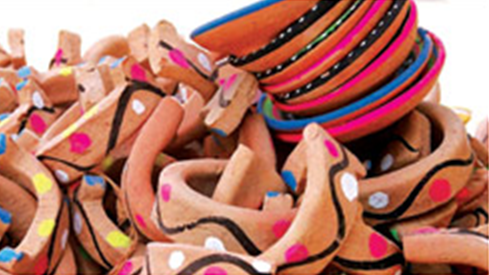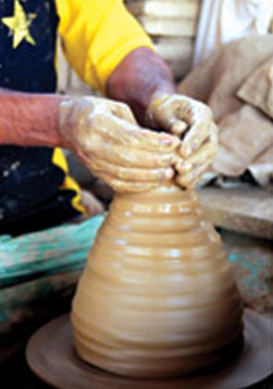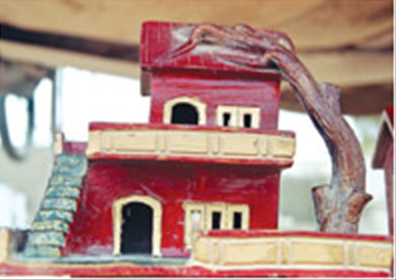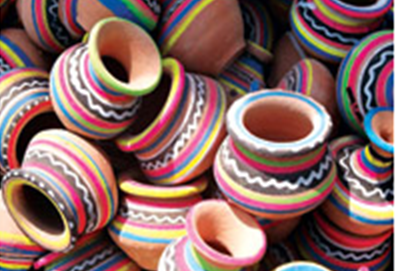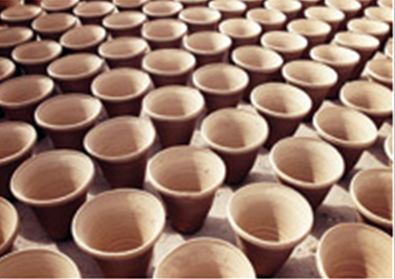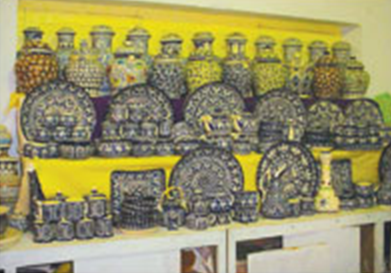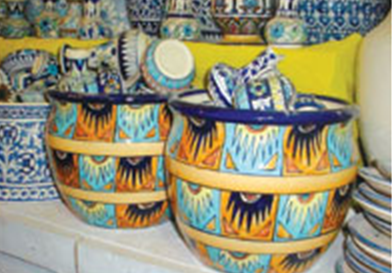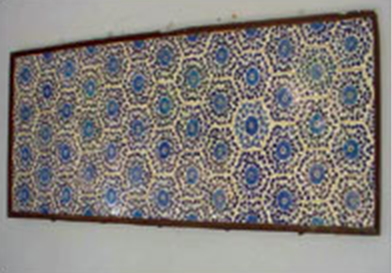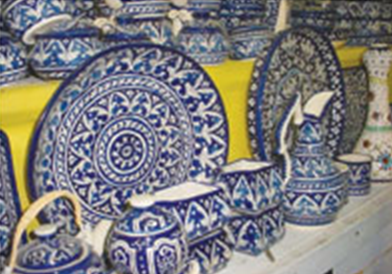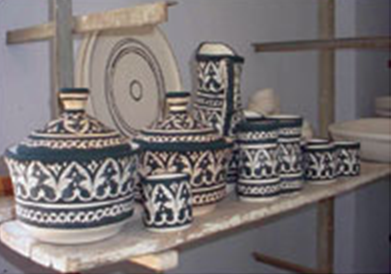Pottery: Pakistan, India
(Created page with "{| class="wikitable" |- |colspan="0"|<div style="font-size:100%"> This is a collection of articles archived for the excellence of their content.<br/>You can help by converting...") |
|||
| (2 intermediate revisions by one user not shown) | |||
| Line 13: | Line 13: | ||
[[Category:Name|Alphabet]] | [[Category:Name|Alphabet]] | ||
[[Category:Name|Alphabet]] | [[Category:Name|Alphabet]] | ||
| − | + | ||
| + | = Andretta = | ||
| + | [http://indiatoday.intoday.in/story/vidya-balan-om-swami-vijender-singh-atul-kochhar-daggubati-venkatesh/1/916159.html Sukant Deepak , The last of the potters “India Today” 10/4/2017] | ||
| + | |||
| + | Over the past 30 years, more than 600 students from across the world travelled to Himachal Pradesh to study pottery with Mansimran Singh (78) and his Cambridge-born wife, Mary Singh (79) at the artists' village of Andretta. But the heyday of Andretta-like the techniques taught here-is fading into memory. | ||
| + | |||
| + | Mary's book, Delhi Blue: A Memoir, was launched on March 28 in conjunction with an exhibition of contemporary ceramics at the Triveni Kala Sangam in Delhi. But it's as much an elegy as a celebration. "From a historical point of view, the book is about the death of pottery as we both knew it," she says. "The [phasing out] of the huge chimneys used in this craft, owing to the pollution they caused, completely altered it." Kangra Valley pots, of the kind that are stored at the couple's Terracotta Museum, cannot be found anywhere now, "except in the dreams of old potters," says Mansimran. The same may soon be true of the studio, which the couple started in 1985, building on the legacy of Mansimran's father Gurcharan Singh, who had founded the Delhi Blue Pottery Society 30 years earlier. | ||
| + | |||
| + | Norah Richards, an Irish actor who first came to India in 1911 and settled here in 1924, sought to establish Andretta as an artists' colony. Though artists like Gurcharan Singh lived here year-round, it really only thrived in the summer. "In the past 20 years, only we have been working consistently in this place," says Mansimran. The future of their museum and studio-and even the pottery itself-is quite uncertain. "We have two children each from our first marriages," the potter says. "All of them are in England. None is interested in pottery. In our will, the family of Shubham Sankhian (20), who left his degree in aeronautical engineering after one year to learn pottery and is still with us, will carry on the tradition, if they want to..." | ||
| + | |||
| + | -Sukant Deepak | ||
| + | |||
| + | |||
=Pottery= | =Pottery= | ||
| Line 51: | Line 63: | ||
Portfolio presentations at the seminar by various potters and ceramists between papers and articles were also well-received. An emphasis on visuals and images on the big screen not only sustained the interest of the students present in the auditorium, they also kept the non-technical audience focussed on the topic. The whole idea behind the event was not to promote art for the sake of art but art that serves a purpose. | Portfolio presentations at the seminar by various potters and ceramists between papers and articles were also well-received. An emphasis on visuals and images on the big screen not only sustained the interest of the students present in the auditorium, they also kept the non-technical audience focussed on the topic. The whole idea behind the event was not to promote art for the sake of art but art that serves a purpose. | ||
| − | [[File: pottery1.png||frame|500px]] | + | [[File: pottery1.png||frame|left|500px]] |
The Kumhar Mela, at the Karachi Arts Council, was the concluding event of the third ASNA triennial. Organised in conjunction with the Ministry of Tourism, the event brought potters from Saran Valley, near Peshawar, Quetta, Khuzdar, Saidpur, Harappa, Nassurpur, Hala, Thar and Badin to display their wares. While the exhibition and seminar fall in line with ASNA’s objectives of bringing contemporary Pakistani ceramics at par with the international art scene, the Kumhar Melawas the second arm of the organisation’s agenda which is to promote local crafts. | The Kumhar Mela, at the Karachi Arts Council, was the concluding event of the third ASNA triennial. Organised in conjunction with the Ministry of Tourism, the event brought potters from Saran Valley, near Peshawar, Quetta, Khuzdar, Saidpur, Harappa, Nassurpur, Hala, Thar and Badin to display their wares. While the exhibition and seminar fall in line with ASNA’s objectives of bringing contemporary Pakistani ceramics at par with the international art scene, the Kumhar Melawas the second arm of the organisation’s agenda which is to promote local crafts. | ||
| Line 59: | Line 71: | ||
For the potters suffering a poor client turnout in their own districts, the Kumhar Mela provided an opportunity to make their niche in the urban market. To this end, other than popularising the event to the general public, ASNA has also directly contacted craft stores which may also exhibit these wares. | For the potters suffering a poor client turnout in their own districts, the Kumhar Mela provided an opportunity to make their niche in the urban market. To this end, other than popularising the event to the general public, ASNA has also directly contacted craft stores which may also exhibit these wares. | ||
| − | [[File: pottery4.png||frame|500px]] | + | [[File: pottery4.png||frame|left|500px]] |
The inclusion of the traditional crafts can help precipitate a revival of the dying craft. For the most part, the Kumhar Melawas all about giving respect and recognition to the craftsmen, who are never appreciated for their toil and labour. Amelioration of their conditions is the main objective of this enterprise, which hails from a spirit of social responsibility towards the underprivileged. — S.K. | The inclusion of the traditional crafts can help precipitate a revival of the dying craft. For the most part, the Kumhar Melawas all about giving respect and recognition to the craftsmen, who are never appreciated for their toil and labour. Amelioration of their conditions is the main objective of this enterprise, which hails from a spirit of social responsibility towards the underprivileged. — S.K. | ||
| + | |||
=Pottery II= | =Pottery II= | ||
| Line 80: | Line 93: | ||
After the items have been given a shape on the potter’s wheel (clay can also be shaped using the coil method, slab method and mould method) by supple, experienced hands, the objects are fired or baked in the kiln. Depending on the object, they are usually then glazed and fired again, producing a brilliant, glossy finished look, while the glaze also helps waterproof the objects. | After the items have been given a shape on the potter’s wheel (clay can also be shaped using the coil method, slab method and mould method) by supple, experienced hands, the objects are fired or baked in the kiln. Depending on the object, they are usually then glazed and fired again, producing a brilliant, glossy finished look, while the glaze also helps waterproof the objects. | ||
| − | [[File: pottery5.png||frame|500px]] | + | [[File: pottery5.png||frame|left|500px]] |
One is not sure how long this craft will survive in this age of synthetic creations. However, one is sure that a carefully made piece of pottery, fired and shaped with passion and using the traditional method, has undoubtedly more character than a bland piece of plastic. | One is not sure how long this craft will survive in this age of synthetic creations. However, one is sure that a carefully made piece of pottery, fired and shaped with passion and using the traditional method, has undoubtedly more character than a bland piece of plastic. | ||
| Line 88: | Line 101: | ||
'' Text and photos by Shakeel Ahmed '' | '' Text and photos by Shakeel Ahmed '' | ||
| + | |||
Multan, in all probability, is the oldest living city in South Asia. It is generally known as the ‘City of Saints’ and lies on the main route taken by almost all the invaders of the subcontinent. It has borne the impact of many armies since the Greek invasion of Alexander in 327BC. It is a prehistoric city famous for its distant past as well as its sacred and artistic traditions, elaborately decorated shrines and attractive handicraft. | Multan, in all probability, is the oldest living city in South Asia. It is generally known as the ‘City of Saints’ and lies on the main route taken by almost all the invaders of the subcontinent. It has borne the impact of many armies since the Greek invasion of Alexander in 327BC. It is a prehistoric city famous for its distant past as well as its sacred and artistic traditions, elaborately decorated shrines and attractive handicraft. | ||
[[File: pottery6.png||frame|500px]] | [[File: pottery6.png||frame|500px]] | ||
| Line 95: | Line 109: | ||
Chinese influence in Islamic pottery-making came after the Mongol domination of Persia in the 13th century. | Chinese influence in Islamic pottery-making came after the Mongol domination of Persia in the 13th century. | ||
| − | [[File: pottery7.png||frame|500px]] | + | [[File: pottery7.png||frame|left|500px]] |
The first example of blue pottery work can be seen on the tomb of Shah Yousaf Gardez. Sultan Mehmood Ghaznavi conquered Multan in 1105 — the starting of the Persian era as far as pottery is concerned — and during this period the art of blue pottery was brought from Central Asia to this region. | The first example of blue pottery work can be seen on the tomb of Shah Yousaf Gardez. Sultan Mehmood Ghaznavi conquered Multan in 1105 — the starting of the Persian era as far as pottery is concerned — and during this period the art of blue pottery was brought from Central Asia to this region. | ||
Latest revision as of 16:10, 7 January 2018
This is a collection of articles archived for the excellence of their content. Readers will be able to edit existing articles and post new articles directly |
Contents |
[edit] Andretta
Sukant Deepak , The last of the potters “India Today” 10/4/2017
Over the past 30 years, more than 600 students from across the world travelled to Himachal Pradesh to study pottery with Mansimran Singh (78) and his Cambridge-born wife, Mary Singh (79) at the artists' village of Andretta. But the heyday of Andretta-like the techniques taught here-is fading into memory.
Mary's book, Delhi Blue: A Memoir, was launched on March 28 in conjunction with an exhibition of contemporary ceramics at the Triveni Kala Sangam in Delhi. But it's as much an elegy as a celebration. "From a historical point of view, the book is about the death of pottery as we both knew it," she says. "The [phasing out] of the huge chimneys used in this craft, owing to the pollution they caused, completely altered it." Kangra Valley pots, of the kind that are stored at the couple's Terracotta Museum, cannot be found anywhere now, "except in the dreams of old potters," says Mansimran. The same may soon be true of the studio, which the couple started in 1985, building on the legacy of Mansimran's father Gurcharan Singh, who had founded the Delhi Blue Pottery Society 30 years earlier.
Norah Richards, an Irish actor who first came to India in 1911 and settled here in 1924, sought to establish Andretta as an artists' colony. Though artists like Gurcharan Singh lived here year-round, it really only thrived in the summer. "In the past 20 years, only we have been working consistently in this place," says Mansimran. The future of their museum and studio-and even the pottery itself-is quite uncertain. "We have two children each from our first marriages," the potter says. "All of them are in England. None is interested in pottery. In our will, the family of Shubham Sankhian (20), who left his degree in aeronautical engineering after one year to learn pottery and is still with us, will carry on the tradition, if they want to..."
-Sukant Deepak
[edit] Pottery
Pottery through history
By Sumera S. Naqvi
Pottery is the expression of man’s affectionate association with clay. Be it earthenware utensils, artefacts moulded from porous bodied clay or porcelain from times immemorial; people have shaped a world of art to reveal their creativity. This love gradually lessened with the highs and lows of times, when cheaper options like plastics took over.
The fascinating link with archaeology also makes pottery a representative of the various periods of history – the way people lived and the approximate dates that they lived in. Today, pottery traditions have been obscured by the thick fog of industrialisation and commercialism.
Though there is no denying the fact that it has been an integral part of the world’s cultures and civilisations, it has not been preserved as duly as the other arts have been. The third ASNA Clay Triennial 2006, held recently, offered food for thought and urged people to make efforts to provide succour to this dying art.
The inaugural event was followed by a two-day seminar where ceramists, potters and researchers addressed issues confronting the industry and traced the history of pottery in the regions.
The keynote speaker, Sheherezade Alam, who calls herself a potter, opened the first day of the seminar with a heartening presentation on how her pottery evolved with ups and downs of her life. Through the seven chapters of her life which endured pain and relief in strange ways, Alam kept reverting to clay to seek solace. And every time she did, her pottery looked more refined and reformed.
Followed by the speeches of Rumana Hussain, editor of Nukta Art, Nilofar Farrukh, the founder member of ASNA, and Marjorie Hussain, art critic, the seminar began with a volley of visual presentations on the historical and contemporary nature of pottery and ceramics in various countries and regions. Stunning artefacts, pots, earthenware, tiles etc. embellished with motifs of traditional local designs of Multan, Sindh, Ajanta and extraordinary glazed and non-glazed finishes of Finnish, Australian, Japanese, Indonesian and Indian origin, were ideally fixed in visuals to transport the audience to the wonderful world of pottery.
To the participants, comprising a mix of students, teachers and art buffs, the international papers were a source of information while the inquiries made on the South Asian soil were a matter of personal enrichment.
Dr Asma Ibrahim’s provoking insight on the vital connection between pottery and archaeology, invited potters and ceramists to join hands and indulge in more research and investigation to ascertain the historical backgrounds and the glorious civilisations that were deciphered through ancient pottery –– the Moenjodaro relics, the Indus Valley civilisation, the Mehargarh period in Balochistan and the Harappan civilisation. “Artefacts do not exist in vacuum they tell us about the psychology and different aspects of the culture of people who produced them,” she said.
Sevim Cizer presented images of the beautiful pottery of Turkey, “revealing the ancient cultures of colour and form; a rich heritage on which contemporary Turkish ceramics has been built,” she said. Various rural villages such as “Karacasu, Menemen and Avanos…have played an important role in preserving traditional forms and production methods.”
Reyaz Badruddin from India made interesting insights on his visit to Japan to see pottery there. Fauzia Aziz Minallah pleaded the case of the potters of Saidpur whose art is on the verge of extinction owing to their marginalisation in the wake of development and construction.
Khristine Michael will be publishing a book in India, based on her research on the history of crafts in the subcontinent as it evolved with craftsmen selling their products in the local markets to eventually exporting them to faceless buyers.
Michael aptly pointed out in her paper that Indian art criticism today does not touch upon the recurrent changes taking place in the traditional practices. She delved into important queries such as ‘what is the meaning of the Indian traditional craft’ and ‘whether it seasoned under Hindu or Islamic manifestations or emerged from an amalgam of local ethnic influences to pick up a corroborated sense of identity’.
The advent of the British Empire in India eventually tailored the crafts to fit foreign designs and demands. She mentioned Dr Alex Hunter, a medical practitioner by profession but very interested in archaeology, who not only contributed to formal art education in India but also developed the industrial design that somehow eroded the typical Indian ethos from the sensibility of the craftsmen.
Ayesha Noorani’s paper emphasised that Islamic art and architecture have been utilitarian in nature, having evolved from Sufi orders. As craftsmen invoked the names of God in their paintings, artefacts and architecture etc., they also felt the divine energy which instilled in them the virtues of love, tolerance and contemplation. “All Islamic art is related to each other and is not in isolation but with a purpose,” she said.
Portfolio presentations at the seminar by various potters and ceramists between papers and articles were also well-received. An emphasis on visuals and images on the big screen not only sustained the interest of the students present in the auditorium, they also kept the non-technical audience focussed on the topic. The whole idea behind the event was not to promote art for the sake of art but art that serves a purpose.
The Kumhar Mela, at the Karachi Arts Council, was the concluding event of the third ASNA triennial. Organised in conjunction with the Ministry of Tourism, the event brought potters from Saran Valley, near Peshawar, Quetta, Khuzdar, Saidpur, Harappa, Nassurpur, Hala, Thar and Badin to display their wares. While the exhibition and seminar fall in line with ASNA’s objectives of bringing contemporary Pakistani ceramics at par with the international art scene, the Kumhar Melawas the second arm of the organisation’s agenda which is to promote local crafts.
By providing a venue for the display of potters’ crafts, opportunities to interact with other artisans and build retail networks in the city; the mela acknowledged the debt of humble beginnings to a country progressing towards globalised aesthetics.
Although some of the participating potters had had some measure of urban contact in each of their respective provinces, most of them had never interacted with each other. Clay work techniques in all parts of Pakistan are distinct from each other, as they depend on the kind of clay available in the region, and the kind of decorative patterns local to the province in which they are produced. Dialogue between craftsmen will not only expose them to materials and techniques being used in other parts of the country but it will also promote healthy competition and improve the quality of their products.
For the potters suffering a poor client turnout in their own districts, the Kumhar Mela provided an opportunity to make their niche in the urban market. To this end, other than popularising the event to the general public, ASNA has also directly contacted craft stores which may also exhibit these wares.
The inclusion of the traditional crafts can help precipitate a revival of the dying craft. For the most part, the Kumhar Melawas all about giving respect and recognition to the craftsmen, who are never appreciated for their toil and labour. Amelioration of their conditions is the main objective of this enterprise, which hails from a spirit of social responsibility towards the underprivileged. — S.K.
[edit] Pottery II
From the potter’s wheel
Text by QAM and photographs by Arsalan
Perhaps it is the primordial clay within man’s essence that binds him to the craft of pottery. For millennia, man has fashioned all sorts of things using the cosmic revolutions of the potter’s wheel, from simple bowls to elaborate sculptures and everything in between.
Even in this land of Sindh, pottery and ceramics have a distinct bond with the region’s culture and history, as we know of the greatness of the Indus Valley civilisation mainly through remnants of its ceramic objects, for instance the bust of the priest king.
Despite the ravages of time the craft of pottery survives — if just barely — in the bustling metropolis of Karachi. The main centre of the city’s pottery cottage industry used to be Lyari’s Kumharwara area, which now plays host to warehouses. The craftsmen have shifted their businesses from that part of town and now, there are two principal kumharwaras in the city: North Karachi and Landhi, while there is also said to be a community in Saeedabad’s Mohajir Camp.
At the kumharwara in North Karachi, where the craftsmen not only work but also live, the kiln, or bhatti where the various objects are fired, can be described as the centre of the colony. It is here that the wet clay is transformed into sturdy, solid objects.
Some craftsmen do display their wares outside their homes, but the kumharwara is not a point of sale; it is more a centre of production and storage. One of the major changes that have taken place over the years is the nature of the potter’s wheel. It used to be powered manually, usually with a foot pedal. But now, the artisans have made use of modern technology and most potter’s wheels are powered by electricity.
With deft handiwork, it seems the practitioners of this ancient craft can seemingly fashion anything. From decorative objects such as brightly coloured dolls, glazed sculptures and other random objets d’art, to more practical items such as water pitchers and flower pots, the potters of kumharwara seem to cater to every taste.
After the items have been given a shape on the potter’s wheel (clay can also be shaped using the coil method, slab method and mould method) by supple, experienced hands, the objects are fired or baked in the kiln. Depending on the object, they are usually then glazed and fired again, producing a brilliant, glossy finished look, while the glaze also helps waterproof the objects.
One is not sure how long this craft will survive in this age of synthetic creations. However, one is sure that a carefully made piece of pottery, fired and shaped with passion and using the traditional method, has undoubtedly more character than a bland piece of plastic.
[edit] Pottery, blue, of Multan
The magic of blue pottery
Text and photos by Shakeel Ahmed
Multan, in all probability, is the oldest living city in South Asia. It is generally known as the ‘City of Saints’ and lies on the main route taken by almost all the invaders of the subcontinent. It has borne the impact of many armies since the Greek invasion of Alexander in 327BC. It is a prehistoric city famous for its distant past as well as its sacred and artistic traditions, elaborately decorated shrines and attractive handicraft.
‘Blue pottery’ is widely recognised as the city’s traditional craft. Its history dates back to the 12th century with obvious traces of Persian influence. The association of religion has given the art of blue pottery a deeper significance and dimension.
Baghdad was the hub of Islamic potters during the 10th century, and blue and green glazes were in vogue.
Chinese influence in Islamic pottery-making came after the Mongol domination of Persia in the 13th century.
The first example of blue pottery work can be seen on the tomb of Shah Yousaf Gardez. Sultan Mehmood Ghaznavi conquered Multan in 1105 — the starting of the Persian era as far as pottery is concerned — and during this period the art of blue pottery was brought from Central Asia to this region.
Outstanding tiled and glazed work can also be seen on the tombs of Bahauddin Zakariya Multani, Shah Rukn-i-Alam, Nawab Saeed Qureshi, Bibi Pak Daman, Musa Pak Shaheed, Shah Hussain Sadozai and Syed Yahya Nawab. In addition to these tombs, blue tiles were also used to decorate mosques.
With the passage of time the local people started to take interest in this art. Those who were involved in this art are called Kashikar and this art is transferred from generation to generation. The area where these families lived was located outside the Daulat Gate and currently it is called Muhallah Kashigaran.
Owing to the lack of patronage, many craftsmen have adopted other professions, but a few families are still continuing with the old profession.
The most prominent craftsmen of this art are Ustad Rahim Bakhsh, Ustad Allah Divaya, Ustad Nazar Hussain (Aga Khan Award winner), Ustad Ahmed Hassan, Ustad Wajid, Ustad Muhammad Sabir and Ustad Zafar Hussain.
Usually Multani clay (red clay) is used for blue pottery, but, nowadays the craftsmen are using white clay along with red clay. In order to promote the craft, the government has also established the Institute of Blue Pottery in Multan.
Traditional Persian designs have now been adapted to cater to the more sophisticated consumers. Apart from the usual urns, jars, pots and vases, there are new products such as tea sets, plates and glasses, jugs, ashtrays and even napkin holders.
The colour palette is restricted to blue derived from the oxide of cobalt, green from the oxide of copper and white, though other non-conventional colours such as yellow and brown have also been added.
Despite the fact that there has been amazing development in mass-production techniques and synthetic materials, the demand for this traditional handicraft has not gone up considerably. Perhaps the government needs to take substantial measures to safeguard and promote this ancient art.
